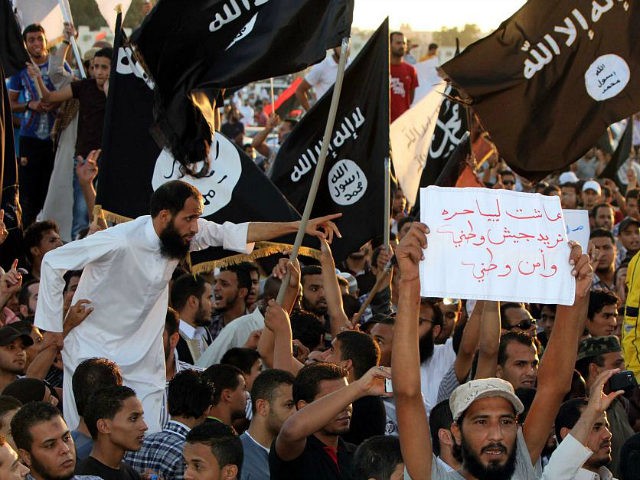U.S.-backed local forces in Iraq and Syria are struggling to contain a “resurgent” Islamic State (ISIS/ISIL) that still retains thousands of jihadis, a watchdog agency warned this week.
The Pentagon’s inspector general (IG) further noted that the “45,000 ISIS supporters and family members” residing at the al Hol refugee camp in Syria represent a menace.
“Minimal security” at the camp for internally displaced persons (IDP) is allowing “ISIS’s ideology to spread uncontested,” the report cautioned.
Published on Tuesday, the latest IG quarterly report to Congress covers activities between April 1 and June 30.
The Pentagon IG revealed:
Despite losing its territorial “caliphate,” the Islamic State in Iraq and Syria (ISIS) solidified its insurgent capabilities in Iraq and was resurging in Syria this quarter. … ISIS is able to operate as an insurgency in Iraq and Syria in part because the Iraqi Security Forces (ISF) and U.S.-backed Syrian Democratic Forces (SDF) remain unable to sustain long-term operations against ISIS militants. … ISIS likely retains between 14,000 and 18,000 ‘members’ in Iraq and Syria, including up to 3,000 foreigners.
The Pentagon IG attributed the Kurdish-led forces’ inability to deal with ISIS to the U.S. decision to reduce its military footprint in Syria. Many Syrian Kurds warned the United States against withdrawing from Syria, saying it would lead to an ISIS revival.
U.S.-backed local forces pushed ISIS out of its last sliver of territory in March, completely decimating the group’s territorial caliphate. However, U.S. military and intelligence officials often warned that the group remained a threat.
Troops from the Syrian Democratic Forces (SDF), a Kurdish-Arab alliance led and dominated by the People’s Protection Units (YPG), are still fighting ISIS in Syria. Kurdish YPG fighters are the armed wing of the Democratic Union Party (PYD) that has maintained control of large swathes of northern Syria with the help of the United States.
The new IG report found that the “partial withdrawal” of U.S. troops from Syria, ordered by President Donald Trump, “decreased” the ability of local forces “to respond to ISIS resurgent cells.”
Pentagon IG officials further noted:
[The U.S.-led coalition] said that the partial drawdown had occurred at a time when these [local] fighters need additional training and equipping to build trust with local communities and to develop the human-based intelligence necessary to confront ISIS resurgent cells and insurgent capabilities in Syria.
“While Syrian forces carried out clearance operations in northeastern Syria to eliminate these cells, [the U.S.-led coalition] reported that U.S.-backed Syrian forces also have limited capacity to hold liberated areas,” a press release announcing the release of the IG report pointed out.
Despite the drawdown of American forces, the U.S. mission in Syria remains the enduring defeat of ISIS as well as al-Qaeda-linked jihadis.
“U.S. goals in Syria also include the removal of all Iranian-led forces and proxies in Syria,” the report said.
The Pentagon IG determined that ISIS remains a threat in both Iraq and Syria, particularly in the form of “sleeper cells” and a growing insurgency.
In Iraq, ISIS continues to establish safe havens, exploiting the security gaps between Baghdad and the Kurdistan Regional Government (KRG) in a swath of territory claimed by both sides.
Northern Iraq is home to the autonomous Iraqi Kurdistan region ruled by the KRG.
Pentagon OIG officials found that ISIS continues to recruit in Sunni majority areas in Iraq, noting:
[The U.S.-led coalition] reported … that ISIS in Iraq is attempting to expand its influence over populations in the Sunni-majority provinces north and west of Baghdad, and has reorganized its leadership and established safe havens in rural Sunni-majority areas. [The U.S.-led coalition] said that “limited information is available to accurately assess if these changes [in leadership] have been successful.”
The press release announcing the IG report noted that the Iraqi security force “often lacks the ability” to maintain control of “territory cleared of ISIS militants, while in Syria, the SDF was ‘initially limited’ in personnel, equipment, and intelligence to confront ISIS’s resurgent cells.”
Before President Trump’s order to reduce the number of U.S. troops in Syria, there were about 2,000 American service members in the country. It is unclear how many remain.
The Trump administration asserted that the 5,000 U.S. troops in Iraq could go into Syria if necessary.
Pentagon OIG officials reported that the Kurdish-led SDF in Syria is unable to keep the “10,000 ISIS fighters” it is currently holding behind bars for much longer.
“Many countries are reluctant to repatriate their citizens held in Syria as ISIS detainees,” an overview of the report said. “Iraq accepted several hundred Iraqi and foreign ISIS detainees from the SDF, but due process and prison conditions there were uncertain.”
The Iranian threat against U.S. troops in Iraq also intensified in recent months.

COMMENTS
Please let us know if you're having issues with commenting.